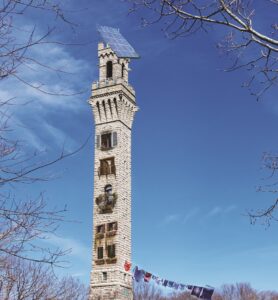DEVELOPMENT
Monument Plan Could House up to 60 Workers
A new waterslide would pay for it
PROVINCETOWN — In this town where creative problem-solving is the norm, officials have announced a plan they hope will go a long way toward addressing one of the community’s most nagging issues.
Their proposal calls for taking the Pilgrim Monument by eminent domain and converting the 252-foot granite structure into a high-rise workforce housing complex. The adjacent Provincetown Museum would be converted into a cafeteria for workers or a large kitchen facility where they could cook their own meals. The complex is within walking or cycling distance of the businesses where many workers are employed.

To help pay for the renovation of the tower into housing, a new waterslide would be built next to the inclined elevator that runs from Bradford Street up High Pole Hill to the base of the monument. Town officials anticipate the slide will be a hit with both tourists and locals.
The history of the Pilgrims’ arrival here in 1620 would continue to be honored by the plaque at the base of the hill.
Each unit in the complex would be designed to house multiple workers. Although plans are still in conceptual form, officials hope the monument could accommodate up to 60 workers. One suggestion is that the topmost room be reserved for an official shark spotter because the monument has a bird’s-eye view of the harbor.
Provincetown businesses have been forced to curtail their hours during peak tourist season because of staff shortages caused by the soaring cost of summer rentals. A current proposal to build a boutique hotel, restaurants, and residential condos on the waterfront has prompted questions about who would staff those new businesses.
During one brainstorming session on the project, one business owner suggested that workers be permitted to sign on for five consecutive tourist seasons at slightly lower-than-legal wages in exchange for help with rent. The arrangement would be drawing on history, he said, noting that many travelers on the Mayflower were indentured servants.
Not everyone thought workforce housing was the best use of the monument; at least one real estate developer would prefer to see a luxury hotel there. “I already have a buyer for the penthouse,” she said.—Christine Legere
RURAL TRURO
Dogs Will Be Unleashed on Walsh Property
Advocates for canine freedom succeed in finding unified vision
TRURO — After more than three years of arguments about housing development and open-space preservation on the 69.9-acre Walsh property, residents have consolidated their conflicting visions to focus on one urgent priority: puppy play.
Unbound and unleashed, dogs will be allowed to roam free on the Walsh parcel.
A new advocacy group, Working Overtime On Freedom for Dogs (WOOFD), conducted a peer-reviewed study of “Area A” — the 28.5-acre section of the property that was briefly considered as a site for community housing. It found that the area’s relative flatness, which made it suitable for building, will also prove ideal for elderly dogs who have trouble getting up and down the dunes leading to Truro’s beaches.
In “Area B” of the property, which encompasses the two North Union Field wells, dogs will be encouraged to play hygienically. They’ll be free to chase, traipse, fetch, and sniff to their hearts’ content but not to relieve themselves — that will be restricted to the easternmost part of the property, away from the Truro Central School and the wellheads.
Truro’s clean water advocates have endorsed the plan as the most environmentally responsible alternative for the land, according to WOOFD.—Sophie Mann-Shafir

PLAY BALL
Silencing Dome Planned for Motta Pickleball Field
PROVINCETOWN — The future has arrived in Provincetown by way of Motta Field — soon to be known as Motta Dome.
Although the two conceptual design schemes presented at a Feb. 8 public meeting were decidedly single-story, the town and its engineering subsidiary, Weston & Sampson, agreed during an executive session to go in a more spherical direction. The move is in response to an online survey about the town’s top issues, in which pickleball access ranked number two following the need to protect cyclists’ right to ride the wrong way on Commercial Street.
The new Motta Dome will feature three levels of up to 14 regulation-size pickleball courts each. The densely packed structure will be encased in a state-of-the-art translucent recycled polyethylene cupola with acoustic silencing technology. Provincetown will be the first town in the nation to pursue this sonic solution.
The select board has authorized an emergency exception to the zoning bylaw to accommodate the facility. Abutters have been asked to submit their opinions on the plan by April 1, using the suggestion box located on the western wall of the former Old Reliable Fish House.
Town officials say the next step is to contend with the Outer Cape’s sizable swimming community, which has advocated for the inclusion of an indoor pool at the site formerly known as Motta Field.
According to reports from town staff, who have requested anonymity for fear of retaliation, the pool people showed up at Recreation Director Brandon Motta’s office in late February in swim caps and goggles and unfurled a kiddie pool at his feet to protest the plan’s pickleball bias. Earlier this week, the pickleball people struck back, swarming Motta’s office with paddles in hand and informing him that they would conduct rallies in the space until the department gets the dome built. One protestor drew a makeshift pickleball court with pink spray paint on the town hall carpet, according to custodial staff.
Weston & Sampson is currently consulting with NASA engineers to nail down the dimensions and technical requirements for the dome.—Amelia Roth-Dishy
HOT COMMODITIES
Parking Space Sells for $3M
PROVINCETOWN — A milestone of sorts was reached last week when a private parking space in Provincetown sold for $3 million — more than double the previous record price.
“It is a gorgeous piece of property,” said Todd Babbitt of Prestige Reality, “a beautiful space in the right part of town.” He described the space as especially generous, exceeding the prescribed dimensions by eight inches in width and a good foot in length. It is not in the floodplain, an important consideration for the buyer.
Asked whether he saw any irony in such a sum being spent on a space for a car in the midst of a housing crisis, Babbitt said he wasn’t aware of any crisis. “I see people all over town; they must live somewhere,” he said. He predicted that the price of parking spaces would continue to go up, with investors speculating in them because they are a limited resource in finite supply. —Dennis Minsky
WOW, VOWS!
Frances Francis Weds Patrick Patrick
Frances Francis and Patrick Patrick were united in marriage on 2-3-23 at Eastham’s Chapel in the Chapel. The ceremony was performed by justice of the peace for the day Bailey Bob Bailey.
The flower girl was the couple’s daughter, Frances Patrick, and the ring bearer was their son Patrick Patrick II. Another daughter, Patricia “call-me-Trish-or-I’ll-hurt-you” Patrick, led the dancing, which included the can-can and the cha-cha, at the gala reception.
The wedding couple and guests dined on mahi-mahi with lomi lomi salad. Bonbons were served for dessert, after which the Francis Patricks headed off on a honeymoon to Bora Bora, joined by their little dog, Toto 2. —K.C. Myers
BOOK REVIEW
Exploring the Cultural History of Outer Cape Maximalism
In Cape Cod Junk, Peter McMahon and Christine Cipriani look at the other side of minimalism
Peter McMahon and Christine Cipriani’s 2014 book Cape Cod Modern: Midcentury Architecture and Community on the Outer Cape ushered in a renewed appreciation for the modernist architecture introduced here by a community of Brahmin bohemians and Bauhaus-educated European émigrés. The book serves both to document the area’s innovative architecture and preserve the memory of the cultural history from which it developed. In their highly anticipated sequel, Cape Cod Junk: The Aesthetics of Maximalism on the Outer Cape, McMahon and Cipriani expand their documentation of the region’s rich visual and cultural history.
The book explores a parallel aesthetic that developed alongside the clean lines and simplified shapes of midcentury minimalist architecture. Tracing the development back to Thoreau’s early observations of a Wellfleet oysterman’s house, McMahon and Cipriani explore a style of architecture and exterior design typified by excess. Over time, undeterred by the less-is-more orthodoxy of their fussy European neighbors, the maximalists of the Outer Cape developed a cacophonous aesthetic achieved through a freewheeling and intuitive use of materials. Unlike the limited range of materials used by the minimalists — usually plywood and cement — maximalist design incorporates wood, plastic, fur, metal, glass, ceramics, rubber tires, boat parts, engines, and lobster traps. “Really, just about anything goes,” says McMahon.
In Cape Cod, Thoreau wrote about the early maximalist impulse here, seeing it in the window arrangements of the Wellfleet oysterman’s house and other houses nearby: “The great number of windows in the ends of the houses, and their irregularity in size and position, here and elsewhere on the Cape, struck us agreeably — as if each of the various occupants … had punched a hole where his necessities required it, and, according to his size and stature, without regard to outside effect. There were windows for the grown folks, and windows for the children — three or four apiece; as a certain man had a large hole cut in his barn-door for the cat, and another smaller one for the kitten … The ends of the houses had thus as many muzzles as a revolver.”
This additive architectural gesture — and the disregard for “outside effect” — has continued to flourish since Thoreau’s visit. Contemporary examples include a Wellfleet property where a boat used as a house has sprouted numerous architectural appendages. The landscape, indistinguishable from the house, furthers the maximalist theme with flags, political signage, ongoing construction projects, materials for future projects, and deteriorating vehicles.
Modernist architecture, in its simplicity and austerity, served the needs of its creative-class inhabitants who, while swimming nude, painting, and playing ping-pong on the shores of Bohemia, did not need much. In Cape Cod Junk, McMahon and Cipriani describe the community of working people behind maximalism, including the lobstermen who created a fad out of the necessity of finding places to store their traps. “While Bauhaus devotees may have coined the phrase ‘form follows function,’ these folks have perfected the notion,” Cipriani told the Independent.
McMahon and Cipriani also devote a chapter to the contributions of artists, which have typically been in the area of interior design. In the book, Raimund Koch produced a series of lushly detailed photographs documenting the home of a Truro couple. Art is everywhere. Sculptures are stacked on top of each other, and paintings are haphazardly hung salon-style from floor to ceiling. Large mounds of manuscripts, newspapers, and books cover floors, except for narrow pathways between rooms.
“The roots of this aesthetic lie in the excess of European cathedrals or Rococo sculpture. It’s a particular American idiom of this sensibility,” writes John Waters, the pope of trash, in a foreword to the book.
Other contributors include Ken Fulk, who in an extended question-and-answer dialogue with McMahon details the painstaking effort he is making to recreate the feel of the maximalist movement by placing the carcasses of three wooden fishing boats on the lawn at the Mary Heaton Vorse house.
The authors of the book are launching a new nonprofit organization along with the publication of the text. Like the Cape Cod Modern House Trust, the organization’s mission is the cultural preservation of the area, with a focus on protecting the best examples of the genre.
Cape Cod Junk is sure to be a must-have on every Cape Cod coffee table, or, depending on one’s style, tossed upon a growing mound of stuff on the floor.—Abraham Storer



